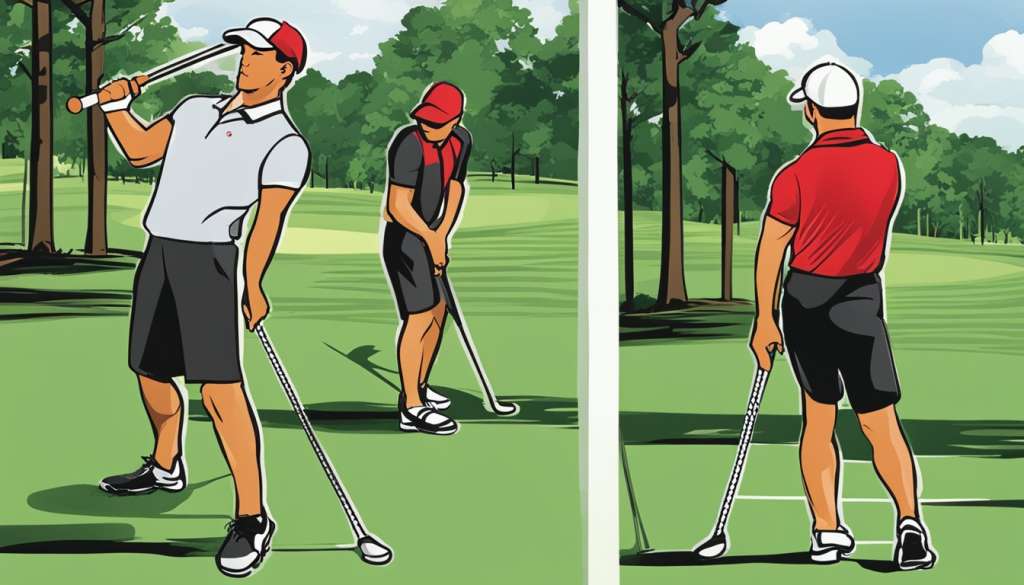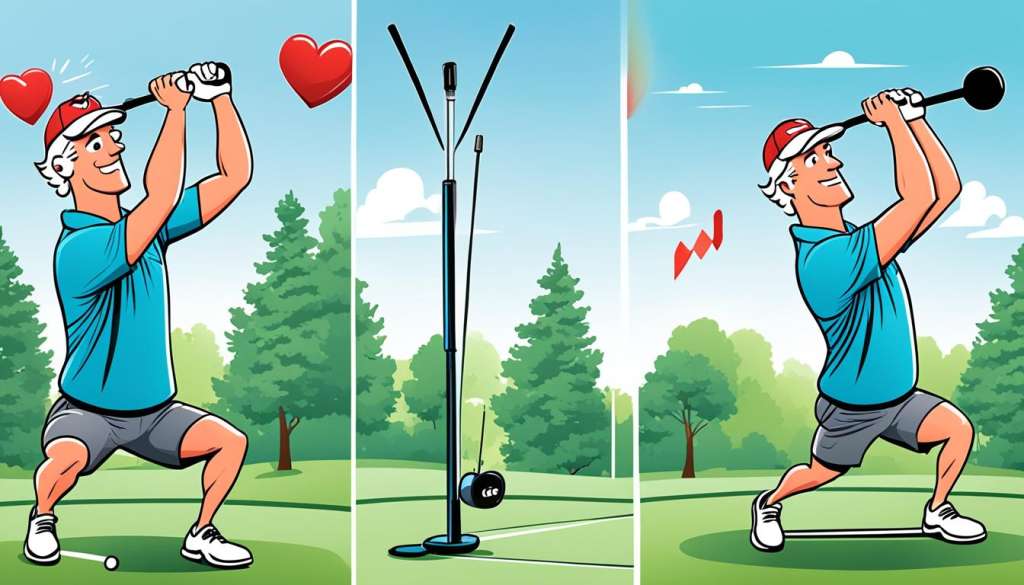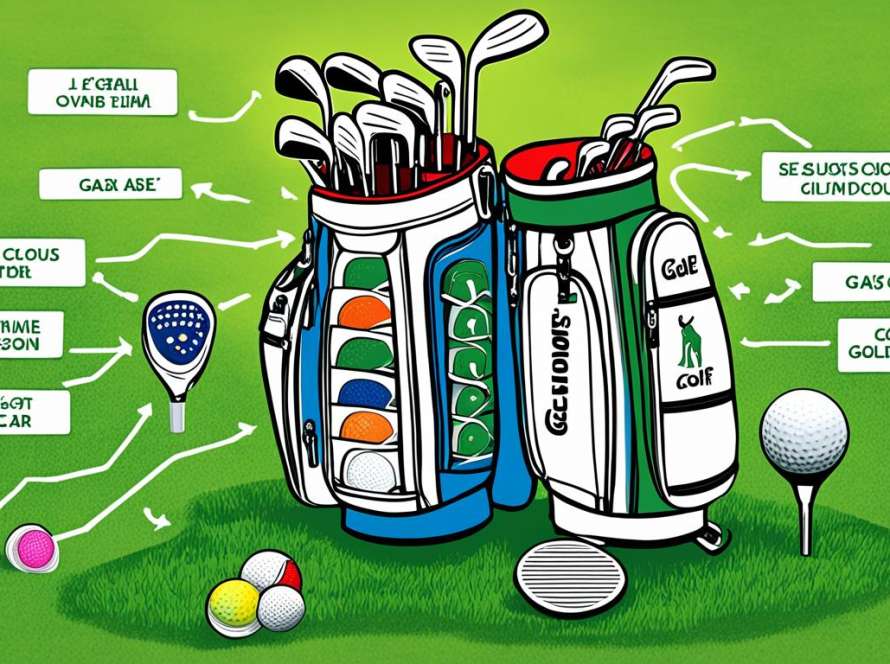Using a Golf-specific Fitness Tracking Guide can boost your golf performance. It helps you keep an eye on important metrics, avoid injuries, and get better at the game. By focusing on golf fitness analytics, you’ll meet the challenges of today’s courses and enhance your overall play.
Golf has changed a lot, with pros like Tiger Woods now focusing on strength training. Your swing needs strength, power, and flexibility. With longer courses and longer drives, tracking your fitness is key to doing well on the golf course.
A detailed guide lets you track your progress in areas like club head speed, flexibility, and core strength. By knowing these metrics, you can focus your training on your weak spots and build on your strengths. This data-driven approach to golf fitness will keep you competitive and let you enjoy the game for a long time.
Understanding the Importance of Fitness in Golf
Golf has changed from a simple hobby to a demanding sport. A Golf Fitness Tracker helps you track your progress. It’s key for building strength and endurance for better golf performance.
The Evolution of Golf Fitness
Old views of golf as a low-impact activity are fading. Today, golfers know they need to stay fit to compete. Top players work on their heart health, flexibility, and strength to play better.
Impact of Physical Conditioning on Golf Performance
Proper strength training can greatly improve your golf game. It makes your club head speed up, increases your drive distance, and makes you more efficient. A strong body also cuts down on injuries by up to 50%.
| Fitness Component | Impact on Golf Performance |
|---|---|
| Strength Training | Increased club head speed and driving distance |
| Flexibility | Improved swing range and reduced injury risk |
| Cardiovascular Endurance | Better stamina for 18 holes and consistency in later rounds |
| Core Stability | Enhanced balance and power transfer during swing |
Debunking Myths About Strength Training for Golfers
Many golfers worry that strength training will hurt their game. But, this belief is being proven wrong. Proper strength training can actually make your swing better and improve your overall game.
Embrace fitness for golf to elevate your game. With the right tools and a Golf Fitness Tracker, you can track your progress. You’ll see real improvements in your performance on the course.
Key Components of a Golf-specific Fitness Program
A well-rounded golf-specific fitness program is key to improving your game. It focuses on the right golf fitness components to boost your performance on the course. Let’s look at the essential elements for your Golf Workout Tracking routine.
Strength and power exercises are the base of a good golf fitness program. They target muscles used in your swing, increasing club head speed and distance. Include deadlifts, squats, and rows to build overall strength.
Flexibility work is also crucial for golf fitness. It helps you swing more smoothly and lowers injury risk. Make sure to stretch your shoulders, hips, and core regularly.
Core stability is crucial in golf. Exercises like planks, Russian twists, and medicine ball rotations strengthen your core muscles. This improves your balance and power during the swing.
- Anti-rotation chops
- Farmer’s walks
- Pallof presses
- Overhead throws
- Medicine ball slams
Don’t forget about cardiovascular conditioning in your golf fitness program. It keeps you going during long rounds and boosts overall health. Add jogging, cycling, or swimming to your routine.
Remember to adjust your training program over the year. In the off-season, focus on building strength and flexibility. As the season comes closer, shift to power development and maintenance to keep your game sharp.
Golf-specific Fitness Tracking Guide: Essential Metrics to Monitor
Tracking your golf fitness is key to getting better at the game. By keeping an eye on important metrics, you can spot areas to work on and see how far you’ve come. Let’s look at the main metrics you should watch for in Golf Exercise Monitoring.
Club Head Speed and Ball Velocity
Club head speed and ball velocity are crucial for your game. They affect how far you hit the ball and your overall power. Use launch monitors to check these metrics during practice. Work on increasing your club head speed with strength training and better swing mechanics.
Flexibility and Range of Motion
Golf needs a lot of motion in your hips, shoulders, and spine. Check your flexibility often with tests like the sit-and-reach or shoulder rotation. Do stretching exercises to get more flexibility and improve your swing and lower injury risk.
Core Strength and Stability
A strong core helps you stay balanced and adds power to your swing. Add exercises like planks and rotational movements to your routine. Keep track of how long you can hold a plank or do rotational exercises right.
Cardiovascular Endurance
Being fit helps you stay focused and full of energy during your game. Watch your heart rate during practice and rounds. Slowly up the time and intensity of your cardio workouts to boost your endurance on the course.
By tracking these metrics regularly, you’ll get useful golf fitness analytics for your training. Remember, getting better in these areas means you’ll play better golf.
Leveraging Technology for Golf Fitness Tracking
Golf technology has changed how we track and improve our fitness on the course. Tools like swing analyzers and GPS watches give us key insights into our game. Let’s see how golf performance analytics can boost your play.
Wearable devices are now key for golfers. They track your heart rate, steps, and calories burned during play. This info helps you understand how hard you’re working out on the course.
Smartphone apps work well with many golf tools. They collect data on your swing speed, ball flight, and putting accuracy. This info helps you see where you can get better in your technique.
Advanced golf analytics platforms take data to a new level. They combine info from different sources to give you a full view of your golf skills. They track your performance over time, guiding your training choices.
Launch monitors give detailed info on how your balls fly. By looking at spin rate and launch angle, you can adjust your gear and swing for better results.
| Technology | Key Metrics | Benefits |
|---|---|---|
| Wearable Devices | Heart Rate, Steps, Calories | Track physical exertion |
| Smartphone Apps | Swing Speed, Ball Trajectory | Improve technique |
| Analytics Platforms | Performance Trends | Data-driven training |
| Launch Monitors | Spin Rate, Launch Angle | Equipment optimization |
By using these golf tech tools, you’re not just playing golf. You’re diving into a world of data that can greatly improve your game and fun.
Designing a Periodized Training Program for Golf
A periodized golf program is essential for boosting your performance on the course. Golf strength training, when done right, can help you reach peak fitness at key times during the season. Let’s look at how to make an effective golf fitness plan.
Pre-season Strength Building Phase
The pre-season phase of your golf program focuses on building a strong base. This 6-8 week period is for building overall strength and muscle. Your workouts should include:
- Compound exercises like squats and deadlifts
- Core strengthening exercises
- Flexibility work to improve range of motion
In-season Power Development and Maintenance
When you start the competitive season, your training shifts to power development. This phase focuses on explosive movements that help your golf swing. Your routine should include:
- Medicine ball throws
- Plyometric exercises
- Golf-specific resistance band work
Off-season Recovery and Cross-training
The off-season is great for active recovery and trying new things. This 4-6 week period helps prevent burnout and keeps you fit. Consider adding:
- Yoga or Pilates for flexibility and core strength
- Swimming or cycling for cardiovascular health
- Light resistance training to keep muscle mass
By following this periodized golf program, you’ll be ready for golf’s physical demands all year. Remember, being consistent in golf fitness planning is crucial for the best results.
Injury Prevention and Recovery Strategies for Golfers
Golf injury prevention is key to keeping you performing well and enjoying the game. By using effective strategies, you can lower the risk of common overuse injuries. This makes your golfing experience better.

Let’s look at some important parts of preventing golf injuries and recovering from them:
- Proper warm-up routines
- Strength training for joint stability
- Flexibility work
- Recovery methods
A good warm-up is crucial before playing golf. It gets your body ready for the game’s physical demands. Include dynamic stretches for your main swing muscles.
Strength training is key for preventing and rehabbing golf injuries. Focus on exercises that boost core stability, shoulder strength, and lower back support. These areas often get overused and injured in golfers.
Flexibility is also crucial. Stretching regularly can increase your swing range and make your swing smoother and stronger. This also lowers the chance of strains.
Golf recovery techniques are vital for staying in top shape during tournaments and intense training. Some top methods are:
| Recovery Technique | Benefits |
|---|---|
| Foam rolling | Reduces muscle tension and improves blood flow |
| Mobility exercises | Enhances joint flexibility and reduces stiffness |
| Hydrotherapy | Promotes muscle relaxation and speeds up recovery |
Adding these golf injury prevention and recovery strategies to your routine can help you avoid injuries. This will also boost your performance on the course.
Nutrition and Hydration: Fueling Your Golf Fitness Journey
A good golf nutrition plan is key for doing your best on the course. Eating right and staying hydrated can boost your golf skills and flexibility. Let’s look at what you should eat and drink to play better golf.
Optimal Nutrition for Golf Performance
Your meals should give you energy all day long. Eat foods with complex carbs, lean proteins, and healthy fats. Here’s a meal plan for a day of golf:
- Breakfast: Oatmeal with berries and nuts
- Pre-round snack: Banana with almond butter
- On-course fuel: Trail mix or energy bars
- Post-round meal: Grilled chicken, quinoa, and vegetables
Hydration Strategies for the Course
Drinking enough water is vital for staying sharp and avoiding tiredness. Start drinking water before you play and keep it up all day. Try to have 4-6 ounces of water every few holes. In the heat, think about drinks with electrolytes to replace lost minerals.
Supplements for Golf-specific Fitness
While eating whole foods is best, some supplements can help with golf fitness. Here are a few to consider:
| Supplement | Benefit | Recommended Use |
|---|---|---|
| Whey Protein | Muscle recovery | Post-round shake |
| Omega-3 Fish Oil | Joint health | Daily supplement |
| Vitamin D | Bone strength | Daily supplement |
By eating right, staying hydrated, and using supplements wisely, you can improve your golf skills and flexibility. This will help you do better on the course.
Integrating Fitness Tracking with On-Course Performance

Your Golf Conditioning Program is more than just gym work. It’s about linking fitness tracking with your performance on the course. This way, you can see how your fitness efforts help you play better golf.
Start by collecting data. Use fitness trackers for your workouts and golf analytics for your game. Together, they give you a full picture of how you’re improving.
Correlating Fitness Metrics with Golf Performance
For better golf, focus on these key links:
- Strength gains and how far you hit the ball
- Flexibility and how straight your swing is
- Heart health and how steady you stay through 18 holes
- Core strength and how well you putt
Tracking these links helps you see which fitness gains help your golf the most. This lets you fine-tune your fitness plan for better golf.
| Fitness Metric | Golf Performance Indicator | Potential Impact |
|---|---|---|
| Club Head Speed | Driving Distance | Increased yardage off the tee |
| Rotational Flexibility | Swing Accuracy | Improved shot precision |
| Core Strength | Putting Stability | Enhanced putting consistency |
| Cardiovascular Endurance | Back Nine Performance | Sustained energy throughout the round |
Golf performance integration is a continuous journey. Keep checking your data, tweak your Golf Conditioning Program, and watch your game improve.
Conclusion
The Golf-specific Fitness Tracking Guide is a key tool for golfers wanting to improve their game. It helps you reach your full potential and take your game to the next level. It focuses on tracking important metrics like club head speed, flexibility, core strength, and heart health.
Improving your golf performance is more than just practicing your swing. It’s about a complete plan that includes strength training, building power, and preventing injuries. Using technology and structured training plans lets you adjust your fitness routine for golf’s different seasons.
A good golf fitness plan is not just about being strong. It also covers eating right, staying hydrated, and using supplements wisely. Combining these with analyzing your performance on the course helps improve your game continuously.
Starting your golf fitness journey means being consistent and patient. The guide offers a plan, but your hard work and effort will make the difference. Adopt this all-around approach, and you’ll see your golf skills improve, one swing at a time.

